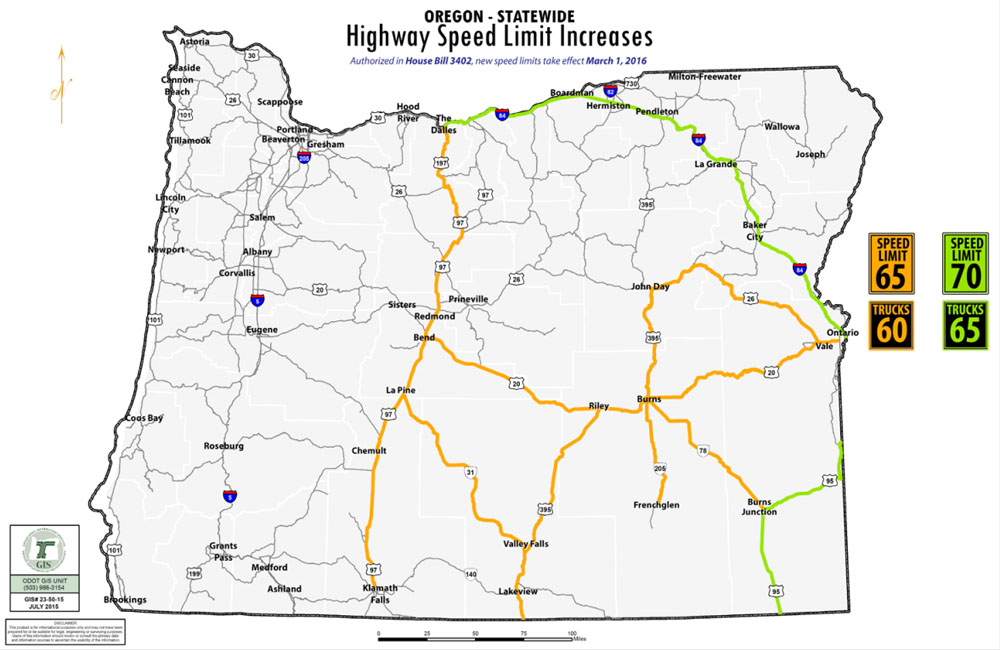Oregon’s New 55 MPH Speed Limit: If you’ve cruised the Oregon freeway recently, you’ve probably noticed drivers feeling a bit more free behind the wheel. Oregon’s new 55 mph speed limit is turning heads and sparking celebrations from Portland to Bend. Whether you’re a weekend road tripper or daily commuter, this change signals a fresh era on Oregon’s highways. This article dives deep into what this means, why it’s happening now, and how it could shape driving culture in the Beaver State.
Oregon’s New 55 MPH Speed Limit
Oregon’s 55 mph speed limit is a deliberate, data-driven balance between freedom and responsibility—giving drivers more room while maintaining safety and environmental goals. Whether you’re commuting across town or driving Oregon’s lush landscapes for work or leisure, this change invites everyone to drive responsibly and confidently. It reflects Oregon’s trust in its drivers, advances in vehicle and road technology, and a commitment to safer, smarter roads. The “Freedom on the Freeway” moment marks a new chapter—embrace it, but always with care.

| Feature | Details |
|---|---|
| New Speed Limit | 55 mph on Oregon highways; previous cap was 45 mph on Bend Parkway |
| Reason for Change | Public demand, improved infrastructure, safety data analysis |
| Safety Monitoring | Annual review on crash rates, fuel use, and traffic congestion |
| Economic Impact | Quicker deliveries, commuter time savings, tourism boost |
| Environmental Focus | Balancing speed increases with fuel efficiency efforts |
| Official Source | Oregon Department of Transportation (ODOT) |
Why the Oregon’s New 55 MPH Speed Limit?
For years, many Oregon highways stuck to lower speeds, with some roads capped at 45 mph. Parts of Bend Parkway, for instance, featured this slower limit, leaving drivers eager for more room to move. Now, Oregon has officially raised the limit to 55 mph on major highways beyond those urban pockets. This shift blends modern transportation needs with safety-conscious policy.
The new limit is the result of years of analysis, public feedback, and technological advancements. Drivers demanded more reasonable speeds to reduce travel times, while safety regulators balanced this with traffic safety data and infrastructure capability. The Oregon Department of Transportation (ODOT) worked extensively to ensure that the increase would not compromise safety but rather enhance traffic flow and driving satisfaction.
The Safety Balancing Act
The U.S. federal government once put a national 55 mph speed limit in place during the 1970s oil crisis to save fuel and reduce accidents. Oregon kept more conservative limits even after the federal rule ended in the 1990s, focusing heavily on driver safety and fuel conservation.
However, today’s vehicles come with advanced safety features not available decades ago. Coupled with improved highway designs and ongoing infrastructure maintenance, the increased speed limit is a calculated update reflecting modern driving realities. ODOT plans to carefully monitor crash statistics, fuel consumption, and traffic patterns over the next year to ensure this speed update continues to protect drivers and communities while enhancing traffic flow and reducing congestion. If issues arise, the limit could be adjusted again to maintain safety.
A Brief History of Speed Limits in Oregon and the U.S.
Understanding Oregon’s speed limit change means looking back at speed regulations nationally. The National Maximum Speed Law of 1974 set the 55 mph cap during the oil embargo to conserve energy and improve road safety. This law was repealed in 1995, and many states raised their limits thereafter.
Oregon’s cautious approach stemmed from its varied terrain—mountainous routes, coastal weather patterns, and dense forestry—which demanded extra caution. Its lower speed limits prioritized safety and environmental concerns for decades. But as vehicles became technologically advanced and road infrastructure improved, maintaining such low limits created bottlenecks and frustrated drivers. The 55 mph update represents a progressive step, balancing safety and efficiency with the needs of modern drivers.
How Oregon’s New 55 MPH Speed Limit Compares?
While Oregon’s 55 mph limit may sound modest, it aligns with many states nationally and regionally. Washington and Idaho have limits up to 70 or 75 mph on their freeways. California and Colorado post 65 to 70 mph limits on many highways, reflecting different traffic densities and road types.
This new limit gives Oregon a competitive edge in supporting commerce and tourism by offering more reasonable travel times while maintaining a core focus on safety and environmental stewardship. In rural Oregon, the statutory speed limit of 55 mph is now more visible and better enforced, with efforts to place signs in compliance with ODOT standards to improve awareness among drivers.
Environmental and Fuel Economy Impacts
It’s no secret that higher speeds typically increase fuel consumption and emissions. But the impact isn’t always straightforward. ODOT recognizes this and is committed to assessing the environmental trade-offs.
At 55 mph, vehicles generally hit a “sweet spot” where fuel efficiency is near optimal compared to higher speeds above 60 mph. Moreover, smoother traffic flow with fewer stop-and-go situations from congestion lowers overall fuel waste. Modern cars are designed with emissions and fuel economy technology that reduces environmental impact even at this increased speed.
Oregon’s strategy includes promoting eco-driving behaviors, advocating for hybrid and electric vehicle use, and maintaining efficient traffic movement to offset emissions. As a result, the increased speed is expected to have a minimal adverse environmental effect compared to the gains in traffic efficiency and reduced congestion idling.
Technology: Driving Safety Forward
Modern vehicle tech plays a pivotal role in supporting higher speed limits safely:
- Automatic emergency braking can prevent or reduce the severity of collisions.
- Lane keep assist helps drivers maintain proper lane positioning on highways.
- Adaptive cruise control smooths out speed fluctuations, enhancing safety in traffic.
- Collision avoidance systems warn drivers of obstacles or sudden hazards.
On the infrastructure front, Oregon has invested in variable speed limit signs that adjust speeds in real-time based on traffic or weather conditions. This dynamic system can automatically reduce limits during rain, fog, or heavy traffic, ensuring drivers slow down appropriately despite the new default limit.

Economic Impact: More Than Just Faster Trips
This speed increase means more than just getting somewhere sooner. Oregon’s economy benefits in several important ways:
- Reduced transportation costs for logistics and delivery businesses, which lowers prices for consumers.
- Increased productivity for workers who spend less time commuting.
- Expanded tourism opportunities, as visitors can comfortably cover more destinations in less time.
- Strengthened local businesses, particularly rural merchants who rely on highway traffic.
Commercial vehicle operators and fleet managers welcome the change because it allows better scheduling and reduces delays.
Voices from the Road
Oregonians buzzed with excitement after the speed limit change. A Portland commuter said, “It’s about time Oregon got up to speed—literally. It feels like the roads finally trust us.” A long-haul trucker commented, “Faster allowed speeds mean more predictable and safer delivery windows, not just faster driving.”
ODOT spokesperson Jane Morales emphasized, “We’re confident in our drivers’ abilities and this decision is backed by science and data. Safety remains our priority.”
How the Oregon’s New 55 MPH Speed Limit Was Implemented?
Speed limit adjustments in Oregon happen through a detailed process. ODOT conducts speed zone investigations that measure driver speeds, traffic volumes, road design, and crash history at specific segments. They rely heavily on the 50th to 85th percentile of observed traffic speeds—reflecting most normal driving behavior. Limits are typically set near the 85th percentile to reduce speed variance and the likelihood of accidents caused by mismatches in vehicle speeds.
Statutory speed limits, like the new 55 mph default, apply on highways unless overridden by local speed zone orders. Some counties—such as Deschutes—do not post 55 mph signs widely because the limit is statutory and drivers are expected to know it, avoiding unnecessary clutter and cost.
In addition to static speed limit changes, Oregon’s variable speed limit program activates automated systems that shift speed limits based on weather or congestion, ensuring drivers stay safe without manual enforcement interventions.

How to Drive Safely at 55 MPH: Pro Tips
- Maintain safe following distances. At 55 mph, keep at least a three-second gap from the vehicle ahead, about 240 feet.
- Keep your vehicle in top shape. Regular brake checks, tire inspections, and light maintenance are essential.
- Pay close attention and minimize distractions. Higher speeds require sharper driver focus and faster reaction times.
- Observe all posted speed limits. Some zones will still have lower limits due to urban areas, work zones, or curves.
- Stay informed about road conditions. Use ODOT’s real-time travel alerts and variable speed signs.
- Adjust driving for weather. Rain, fog, or snow reduce traction; reduce speed below the posted limit accordingly.
US Visa Waiver Program 2025 Just Updated; Here’s Who Can Now Enter America Without a Visa
NJ Judge Loses $140K Pension Over ‘Serious Breach of Public Trust’; Here’s What Went Wrong
Federal Government Reopens; Here’s What SNAP, IRS, TSA & Federal Workers Can Expect Now








